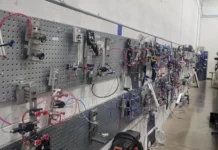by Matt Proske, vice president
SIGMA Plastic Services, Inc.
Improving mechanical properties and/or weight reduction requires finding ways to improve stiffness while reducing weight. Fiber-filled polymer materials have been the number one choice to accomplish these goals, but the transition has not been easy or straightforward.
The primary challenge has been that increasing fiber content in polymers makes their shrinkage more difficult to predict and control. Adding the fiber content into polymers to enhance their mechanical properties further increases the complexity of understanding how the final part will perform. Aspects such as rotation of fibers during filling, final fiber orientation, fiber degradation, higher fiber fill content, anisotropic shrinkage and long glass fibers are just a variety of examples of the daily challenges plastic manufacturers encounter. The replacement of metal parts with fiber-filled polymers has been a significant uphill battle for the injection molding industry.
Understanding the behavior of thermoplastics in the injection molding process
Each polymer has individual material properties and, as such, behaves differently under the same conditions, resulting in the need for processing changes when different polymer grades are used. Thermoplastics behave differently according to their polymer structure, which can be subdivided as semi-crystalline and amorphous material types.

One fundamental characteristic common among all thermoplastic materials is their non-Newtonian flow behavior: Viscosity decreases with increasing shear rates. The change in viscosity as a function of shear rate creates the commonly known fountain flow, which exists when the melt front at the center of the wall thickness flows ahead of the melt at the walls (Figure 1). The polymer viscosity also is affected by the addition of fillers into the material, where – depending on the type of filler and filler content – it can increase/decrease the viscosity, thermal conductivity, specific heat, shrinkage and crystallinity.
A second characteristic also common among thermoplastics is their tendency to shrink volumetrically during the cooling process. However, the shrinkage is often nonuniform. This is related to their polymer structure and fillers, but also dependent on processing choices and local mold temperatures, resulting in differential cooling. During the injection molding process, a hot melt is introduced into a cold mold over multiple consecutive cycles. The reproduction of the same process over these multiple cycles creates a quasi-steady state during which the mold will maintain the same temperature changes throughout each cycle and produce very similar part quality during a production run.
Another characteristic is the viscoelastic nature and behavior of polymers, which can directly influence the final mechanical properties. The time- and temperature-dependent nature of the polymer during the injection molding process can and will affect the stress field in the part. The Young’s modulus of the material increases in the areas where the melt solidifies and remains low at the molten areas. The differential cooling of the part will affect how the local stresses are created, while the part is constrained by the mold during the cooling time. The constraint of the mold disappears when the product is removed from the mold. Stresses in the article relax, and the article continues to cool and shrink outside of the mold – all in a nonuniform way.

Similarly, a fiber-reinforced material will still show the viscoelastic behavior, but also will have an anisotropic shrinkage (orientation affects local shrinkage rates). The use of fibers in polymer materials helps in transferring some of the stresses to the fibers, increasing the mechanical properties. The type of fiber, aspect ratio, fiber content and fiber length will affect the injection molding process. Fibers oriented in the flow direction vs. cross-flow will produce this differential shrinkage, as well as the final anisotropic strength and stiffness (Figure 2). Final fiber orientation between the surface and middle regions of the wall thickness throughout the entire part will not be the same and will introduce a multiaxial stress in the interior. Molten material entering into the cavity during packing also will affect the fiber orientation.
Reproducing the behavior of thermoplastics in computational simulations
The proper reproduction of the thermoplastic behavior using computational simulations not only relies on the quality of the material data, but also on the meshing technology and the models used by the solvers to calculate physical behavior.
The polymer properties are measured using a series of tests that capture the essence of their physical nature. The properties needed to simulate the molding process can be divided into four categories: thermophysical, rheological, mechanical and morphology. Similarly, mold and insert materials also must be described with thermophysical and mechanical properties.
Once the material properties are measured, the information is imported into the material database calculator and fitted using models that will be used by the solver. The solver requires a mesh, which is a system composed of finite volumes and points of calculation. In order to easily mesh the complete complex molding system composed of multiple different materials and individual geometries, a finite volume method mesh (FVM) is used.
Simulating the injection molding process of a fiber-filled material
The FVM mesh always represents a three-dimensional calculation using the Fourier and Navier-Stokes equations of heat transfer, and mass, energy and momentum considering gravity and inertia. The heat and fluid flow of the injection molding process are calculated simultaneously using parallelized computing power limited only to the hardware capabilities. This coupled simulation removes the necessity of boundary conditions and ideal temperatures by simulating the exact injection molding process.
A thorough and extensive introduction of the challenges to reproduce the injection molding process was necessary to define the differences between part design analysis and comprehensive process simulation.

Comprehensive process simulation includes the injection molding process utilizing all the mold components, heating/cooling system, inserts, part and polymer delivery system (gate, runner, hot runner) with independent thermodynamic, rheological, mechanical and morphology properties. This is possible due to the ability to generate a mesh of the entire tool using the FVM (Figure 3).



Such a comprehensive model computes the molding process over multiple consecutive production cycles using a predefined process (Figure 4). The mold loses heat to the environment at the surface when in the open position and transfers heat across the parting line when closed. The cold and hot areas are easily identified and based on the temperature history, as well as cooling layout. The temperature change in the mold is based on the local shear rates and melt temperatures entering the cavity over multiple cycles. The ability and effectivity of the properties of the mold materials and cooling lines to dissipate the heat, maintaining a uniform surface temperature (Figures 5 and 6), also is factored.

When simulating fiber-filled materials, the orientation can be tracked down at any time during the process and at the surface or subsurface regions. It is crucial to understand the effect of the gate locations in the final fiber orientation. The fibers will have a flow-induced fiber orientation during filling. As the part cools

down and the material shrinks, externally applied pressure (called packing pressure) forces melt into the cavity to compensate for the contracting material. Thus, the fiber orientation changes continuously during the filling and packing process. Figures 7 and 8 show some examples of fiber orientation changes due to number of gates, gate locations and changes to the molding process for filling and packing definitions.

The ability to force more melt into the mold cavity during packing changes based on the gate locations, packing pressure and packing time. During the packing phase the material begins to solidify at different rates, depending on the local temperatures and part design (wall thickness). There are areas where the material will become isolated and will not be compensated for the liquid shrinkage. Isolated areas increase the possibility for higher sink marks and voids. Figure 9 shows the areas that remain connected to packing (red), isolated (blue) and solidified (transparent) at different times during packing and cooling.


Local stresses will differ within the part as a result of differential cooling and when the shrinking occurs. Areas that remain molten for a longer period of time will have a lower modulus in contrast with the solidifying areas with higher modulus. In addition, the part will be constrained by the mold as it solidifies. There is a possibility of the part sticking into the mold as a result of extended cycle times. The force required to eject the part may exceed its modulus and puncture it or leave a mark behind. Furthermore, the applied forces to certain areas will increase the local stresses (Figures 10 and 11). This often is the result of improper cooling within the mold. Isolated hotspots can drive extended cycle times.

The final distortion of the part (Figure 12) is a combination of all the above described calculations: independent properties of each material, full process information, multiple cycles, differential cooling, fiber orientation (in this example), packing time, cooling time and part ejection.
The complex nature of manufacturing processes essentially requires specifically developed software programs to capture enough detail of the real process that the root cause of real-world problems can be understood and resolved.
Matt Proske holds a degree in manufacturing engineering from Kent State University and has 20 years of experience in aluminum casting, high-pressure die casting and injection-molded polymers. SIGMASOFT® Virtual Molding is a comprehensive process model used to allow polymer processors significant insight into the production system in advance of building. Virtual Molding’s broad suite of software modules allow companies to optimize their molding systems on every project, whether simple or complex. For more information, visit www.virtualmolding.us.




